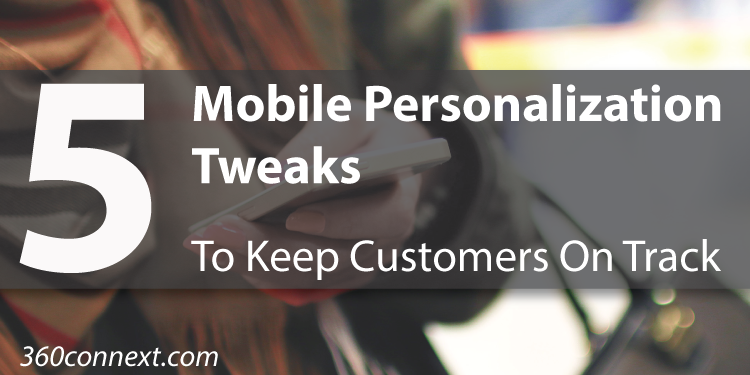We’re moving into an age that is becoming more and more mobile. Every conference speaker I’ve seen for the past several years has discussed the importance of designing customer experiences around our obsession with mobile devices. Who doesn’t want to deliver a personalized mobile experience for each customer via those tiny screens?
And yet we’re still so far away from really considering how to personalize the experience for mobile.

Here are five mobile personalization tweaks to keep customers from losing their way at crucial moments in the journey.
Have you ever tried to schedule something like an appointment for a dentist or a massage online? These convenient scheduling tools available on the desktop version become almost impossible to use on mobile devices. Yes, they are “optimized” in a generic sense, but not really. These tools and others like them don’t help users through a better mobile experience, just a smaller one. It’s frustrating and forces users to wait to take action, which could be the kiss of death for your product or service offering.
Creating a simplified and more navigable experience could mean offering ways to select dates and times via more than one method. Instead of using just the same clickable buttons on a calendar grid or vertical scroll, for example, it might be better to offer “select the date you want” methods on mobile. Savvy providers are already offering this, but there is a whole world of those who aren’t.

It still baffles me whenever I look up a retailer or local service on my mobile phone and don’t see the phone number and address immediately. Hunting around for the tiny “Contact Us” in their menu is silly. If a user is looking up your service, offer what they might want right away. And for goodness sake, make the phone number click-to-call.
Customers should also be able to login to an account without hunting around for the microscopic “login” link, too. Find ways to create a useful mobile menu.
Previous search histories help both the customer and the retailer with more purchases. Mobile is still behind in this, with a recent report from Retail Systems Research showing a whopping 83 percent of mobile sites did not recall past search histories!
These search histories could help users locate what they want immediately and take action.
We’re used to seeing recommendations for other products as we are searching online. Customers appreciate and often act on those helpful recommendations like “Frequently Bought Together” or “People Also Viewed” categories. This feature is missing in many mobile experiences. By creating recommendations for the customer who not only bought this product, but also bought it via a mobile device, retailers could offer even more personalized products.
For example, if I buy workout clothes via my mobile device, the recommended products might also include accessories like earbuds and armbands to carry said device when I work out.

Providing experiences with personalized messaging goes a long way. Many mobile experiences just skip this step. Offer a greeting that takes up some real estate on the screen, then make it easy to move on. Mobile can be fun!
Mobile experiences are here to stay, and our approach to them should be about personalizing the experience in different ways than just shrinking the graphics and words.
Image credits: BuildArk, Jimmy_Joe via Creative Commons license
 Jeannie is an award-winning customer experience expert, international keynote speaker, and sought-after business coach who is trailblazing the movement from “Reactive Customer Service” to “Proactive Customer and Employee Experience.” More than 500,000 people have learned from her CX courses on LinkedIn Learning, and her insights have been featured in Forbes, The Chicago Tribune, The Wall Street Journal and NPR.
Get Jeannie’s insights in your inbox each week by subscribing to The Weekly Win and follow her on LinkedIn, Instagram and YouTube.
Jeannie is an award-winning customer experience expert, international keynote speaker, and sought-after business coach who is trailblazing the movement from “Reactive Customer Service” to “Proactive Customer and Employee Experience.” More than 500,000 people have learned from her CX courses on LinkedIn Learning, and her insights have been featured in Forbes, The Chicago Tribune, The Wall Street Journal and NPR.
Get Jeannie’s insights in your inbox each week by subscribing to The Weekly Win and follow her on LinkedIn, Instagram and YouTube.